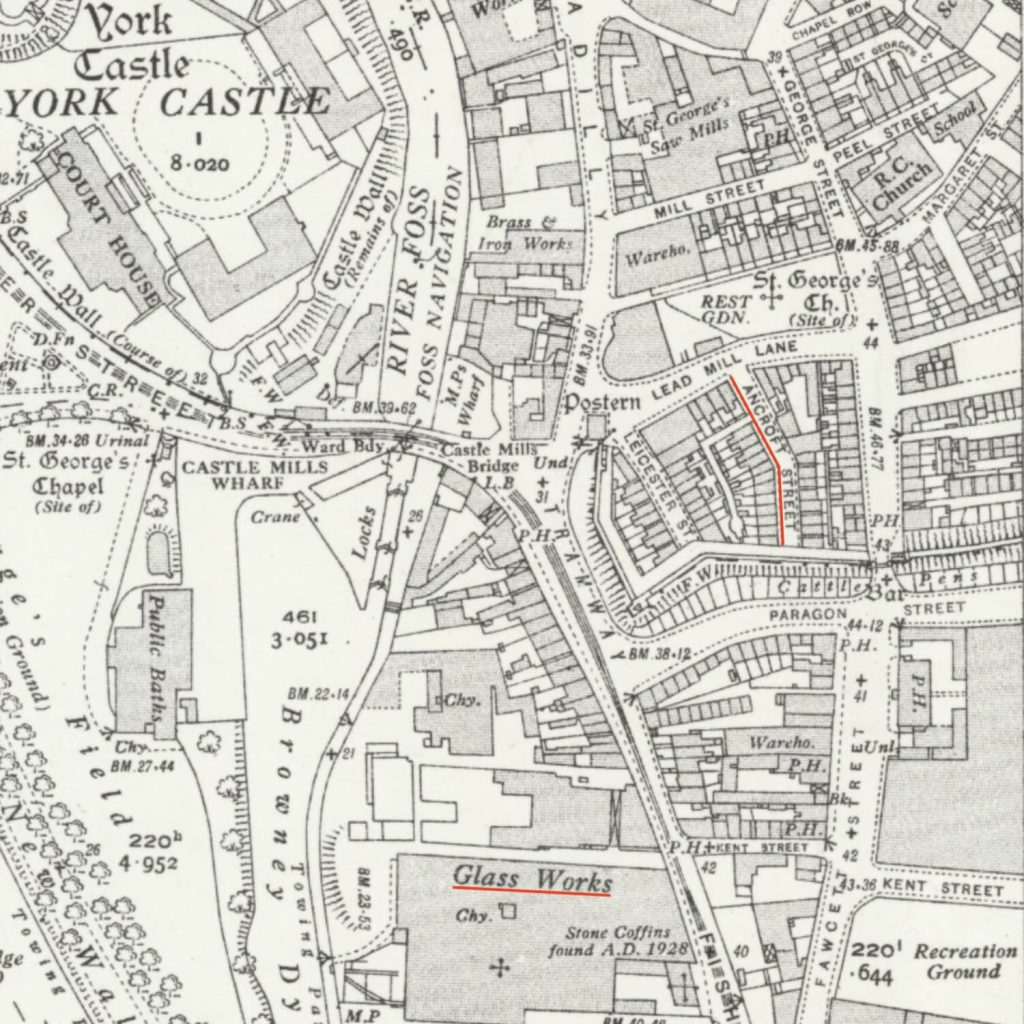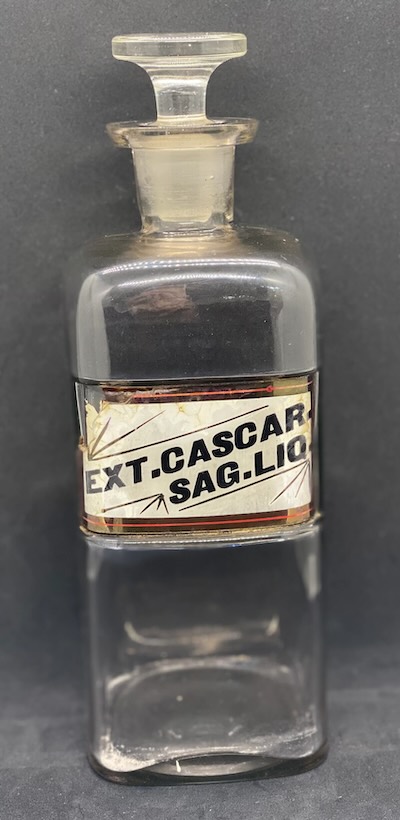Lizzie Edgar & The Bottle Stopperers

Our Great Grand Aunt, Elizabeth Edgar (1870-1956), was born in Newcastle Upon Tyne, Northumberland, the third of twelve children. Aunt Lizzie relocated to York with her parents, Ann LUMSDOM and John Thomas EDGAR, who worked as an engine fitter on the railways, until she entered domestic service for a family on Coney Street.
At the age of 21 she married Timothy McDonald, a third generation bottle stopperer. Their house on Ancroft Street, highlighted in red below, was located just inside the city walls and a short walk from his employer, York Glass Works. Uncle Tim worked as a bottle stopperer for more than 40 years.

In business for a century (1830-1930), the York Glass Co. produced medicinal bottles in a variety of colors including green, blue-green, cobalt blue, and flint. The firm used a single complex logo embossed on the base of glass containers and impressed into ceramic bases.
The bottle stopperer would grind the shank of the bottle stopper to fit a specific bottle exactly, and the bore of the bottle ground, to ensure a perfect fit. Up until around 1940, pharmaceuticals were stored and dispensed from the glass containers, sealed with glass bottle stoppers. After that, the medications started to be dispensed as tablets or capsules.

Bottles with ground glass stoppers were two or three times more expensive than the equivalent bottle without a glass stopper so it is not surprising that most bottles of this are used where the contents were accessed repeatedly.
The production of glass stoppers and accompanying bottles were therefore critical during war time as the casualties mounted and hospitals burned through medicinal supplies. So important was the glass bottle manufacturer that the occupation was a protected career allowing glass bottle stopperers to avoid conscription. Admittedly uncle Tim was over the age of conscription by the outbreak of WWI.
My second memory was also during the First World War. My father was in a protected job in the glass industry. He had a highly specialised job as a ‘glass bottle stopperer’, grinding glass stoppers that fitted into medical carriers; vital to carrying much needed medical drugs to the front line for treating wounded troops…
Ron Taylor, The Early Years, Britain at War
Lizzie & Tim’s three sons Augustus, Wilfrid, & George, continued to live in central York with their own families. Augustus served as a batman with the Royal Flying Corp during WWI before returning to his career as a hairdresser. Wilfrid worked as a machinist for a cardboard box manufacturer. George was a coach painter at the railway works. By the end of 1930’s uncle Tim had retired from the glass works and started working as a scene shifter at the Empire Theatre.

The couple’s location in central York was especially appreciated by their nephews and nieces once their own sons moved out the house. Their nephew Kenneth Bainbridge lived with them, during 1939 (see above), while he was serving his apprenticeship with the railways in central York. It reduced his commute compared to traveling from Newton on Ouse. Ken stayed with Tim & Lizzie up until he joined the Royal Navy.

Our cousin Karen was doing a little family history and asked her aunt, Doreen Bainbridge, about her early life in Newton on Ouse. Doreen described her experience working for the Post Office on shifts in the Telegraph Office in York.
The winter of 1947 sank the country to a level of deprivation unknown during the war. The winter arrived with a vengeance as the country was gripped in an arctic freeze that lasted for two months. Snow storms whipped up into monstrous drifts which buried roads and railways. The temperatures fell far below 0ºC and the whole country became snowbound.
The roads were so bad, Newton on Ouse was cut off, so Doreen walked to York with a neighbour Bernard Jefferson, son of a LNER railway worker. Doreen only missed the first part of her shift, despite the weather, when in some places she was up to her waist in snow. She received a letter from the Postmaster General in London commending her. She also carried tins of soup because she would then stay with Aunt Lizzie!
Family Tree
- Benjamin ONIONS (1795-1853) & Jemima ABEL (1797-1869)
- Martha Edgerton ONIONS(1822-1890) & Unknown
- John Thomas ONIONS (1842-1924) & Ann LUMSDOM (1849-1925)
- Jane Ann Edgar (1867-)
- John Thomas Edgar (1869-1947)
- Elizabeth Edgar (1870-1956) & Timothy McDonald (1868-1953)
- Augustus McDonald (1892–1974)
- Wilfrid Harold McDonald (1894–1990)
- Mabel McDonald (1897–1912)
- Hector McDonald (1900–1912)
- George Ernest McDonald (1910–2004)
- Martha Edgar (1873-1968)
- Maude Mary Edgar (1875-1968)
- Margaret Edgar (1878-1881)
- William Edgar (1880-1938)
- Margery Edgar (1883-1904)
- Robert Edgar (1885-1962)
- Adelaide EDGAR(1888-1975) &John Henry BAINBRIDGE(1892-1940)
- Charles Reginald BAINBRIDGE(1915-1994)
- Kenneth Norman Bainbridge (1920-2007)
- Ronald Geoffrey Bainbridge(1924-2022)
- Donald Edgar Bainbridge (1926-1972)
- Doreen May Bainbridge (1928-2013)
- James Albert Edgar (1891-1960)
- Andrew Edgar (1899-1902)
- John Thomas ONIONS (1842-1924) & Ann LUMSDOM (1849-1925)
- Martha Edgerton ONIONS(1822-1890) & Unknown
References
- The York Glassworks Fishergate: A brief history by Van Wilson
- The York Glass Co. and the YGCo Logo, Bill Lockhart, Beau Schriever, Bill Lindsey, Carol Serr, and Bob Brown, The Society for Historical Archaeology
- Bottle Finishes & Closures, Part III: Types of Bottle Closures, SHA.org
- Liquid Medicines and Medicine Bottles, Royal Pharmaceutical Society Museum
- RED – Redfearns National Glass Company Records, National Archives
- Explore York Libraries & Archives
- York Family History Society
- 9 Ancroft Street, York, Ordnance Survey 25 inch England and Wales, Yorkshire CLXXIV.10, Revised: 1929, Published: 1936, National Library of Scotland
- The Early Years, Britain at War
- Rare York Glass Company Patent LUG Oil Chemist Bottle, The Antique Dispensary
- Large Antique Clear Glass Chemist Bottle. PULV: PUMICE: with Original Foil Label and Ball Stopper, Iconic Edinburgh
- Antique Apothecary Chemist York Glass Company Measuring Bottle Jug Flask, Retrovation
- Antique UK Apothecary Bottle by YG Co. c 1880- Ext. Cascar Sag. Liq. (Cascara), Cache Antiques
- Set of York Glass Company Pharmacy Apothecary Chemist Bottles, Bourne in time Antiques










